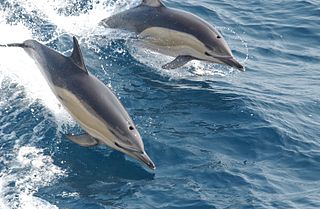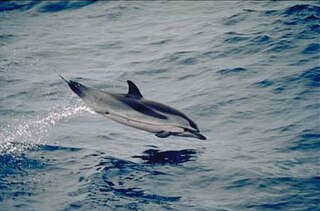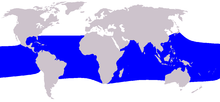
The white-beaked dolphin is a marine mammal belonging to the family Delphinidae in the suborder Odontoceti.

The Indo-Pacific finless porpoise is one of eight porpoise species. The species ranges throughout most of the Indian Ocean, as well as the tropical and subtropical Pacific from Indonesia north to the Taiwan Strait. Overlapping with this species in the Taiwan Strait and replacing it northwards is the East Asian finless porpoise.

The strap-toothed beaked whale, also known as Layard's beaked whale, is one of the largest members of the mesoplodont family, growing to 6.2 m (20 ft) in length and reaching up to 1,300 kg (2,900 lb). The common and scientific name was given in honor of Edgar Leopold Layard, the curator of the South African Museum, who prepared drawings of a skull and sent them to the British taxonomist John Edward Gray, who described the species in 1865.

True's beaked whale is a medium-sized whale in the genus Mesoplodon. It is native to the northern Atlantic Ocean. The common name is in reference to Frederick W. True, a curator at the United States National Museum.

The Irrawaddy dolphin is a euryhaline species of oceanic dolphin found in scattered subpopulations near sea coasts and in estuaries and rivers in parts of the Bay of Bengal and Southeast Asia. It closely resembles the Australian snubfin dolphin, which was not described as a separate species until 2005. It has a slate blue to a slate gray color. Although found in much of the riverine and marine zones of South and Southeast Asia, the only concentrated lagoon populations are found in Chilika Lake in Odisha, India and Songkhla Lake in southern Thailand.

The common dolphin is the most abundant cetacean in the world, with a global population of about six million. Despite this fact and its vernacular name, the common dolphin is not thought of as the archetypal dolphin, with that distinction belonging to the bottlenose dolphin due to its popular appearances in aquaria and the media. However, the common dolphin is often depicted in Ancient Greek and Roman art and culture, most notably in a mural painted by the Greek Minoan civilization.

The harbour porpoise is one of eight extant species of porpoise. It is one of the smallest species of cetacean. As its name implies, it stays close to coastal areas or river estuaries, and as such, is the most familiar porpoise to whale watchers. This porpoise often ventures up rivers, and has been seen hundreds of kilometres from the sea. The harbour porpoise may be polytypic, with geographically distinct populations representing distinct races: P. p. phocoena in the North Atlantic and West Africa, P. p. relicta in the Black Sea and Sea of Azov, an unnamed population in the northwestern Pacific and P. p. vomerina in the northeastern Pacific.

Burmeister's porpoise is a species of porpoise endemic to the coast of South America. It was first described by Hermann Burmeister, for whom the species is named, in 1865. Locally it is known as marsopa espinosa and chancho marino.

Humpback dolphins are members of the genus Sousa. These dolphins are characterized by the conspicuous humps and elongated dorsal fins found on the backs of adults of the species. They are found close to shore along the coast of West Africa and right along the coast of the Indian Ocean from South Africa to Australia. Several institutions have made a proposal to divide the Indo-Pacific species into two distinct species: the Indo-Pacific humpback dolphin and the Australian humpback dolphin.

Peale's dolphin is a small dolphin found in the waters around Tierra del Fuego at the foot of South America. It is also commonly known as the black-chinned dolphin or even Peale's black-chinned dolphin. However, since Rice's work Peale's dolphin has been adopted as the standard common name.

The pantropical spotted dolphin is a species of dolphin found in all the world's temperate and tropical oceans. The species was beginning to come under threat due to the killing of millions of individuals in tuna purse seines. In the 1980s, the rise of "dolphin-friendly" tuna capture methods saved millions of the species in the eastern Pacific Ocean and it is now one of the most abundant dolphin species in the world.

The spinner dolphin is a small dolphin found in off-shore tropical waters around the world. It is famous for its acrobatic displays in which it rotates around its longitudinal axis as it leaps through the air. It is a member of the family Delphinidae of toothed whales.

The Clymene dolphin, in older texts known as the short-snouted spinner dolphin, is a dolphin endemic to the Atlantic Ocean. It is the only confirmed case of hybrid speciation in marine mammals, descending from the spinner dolphin and the striped dolphin.

The striped dolphin is an extensively studied dolphin found in temperate and tropical waters of all the world's oceans. It is a member of the oceanic dolphin family, Delphinidae.





















